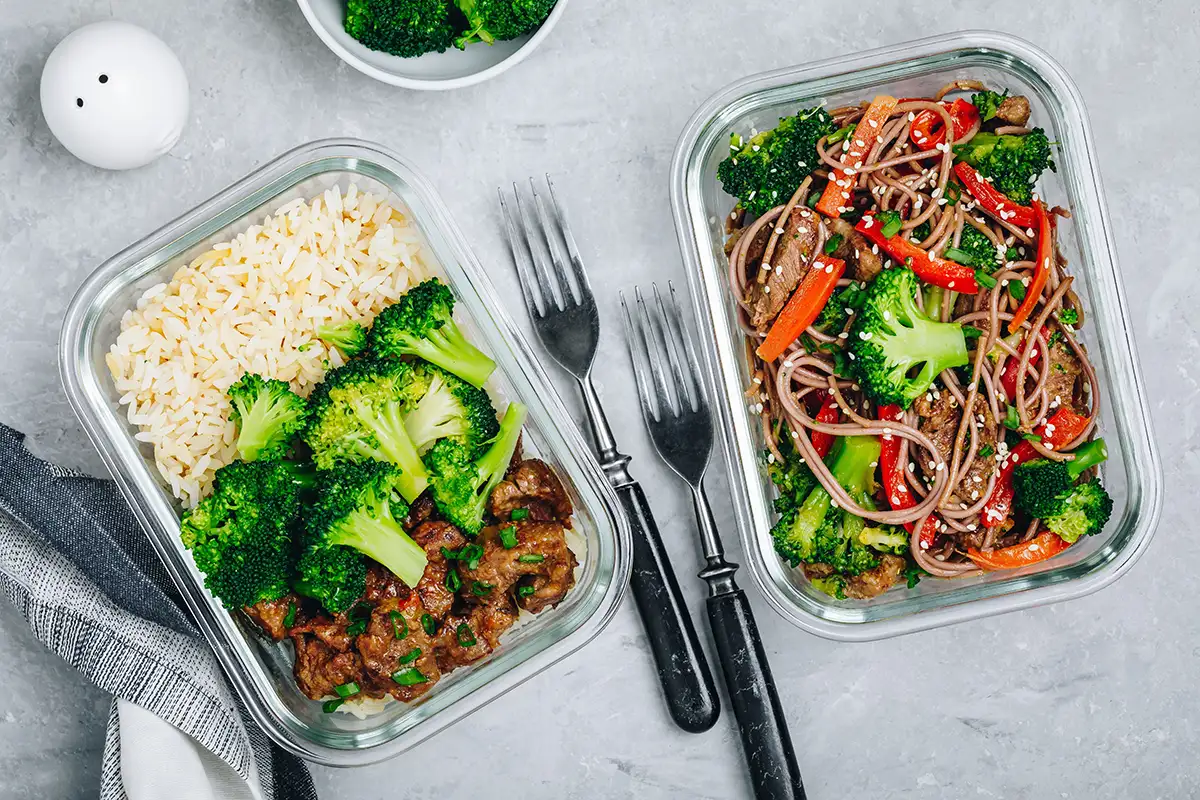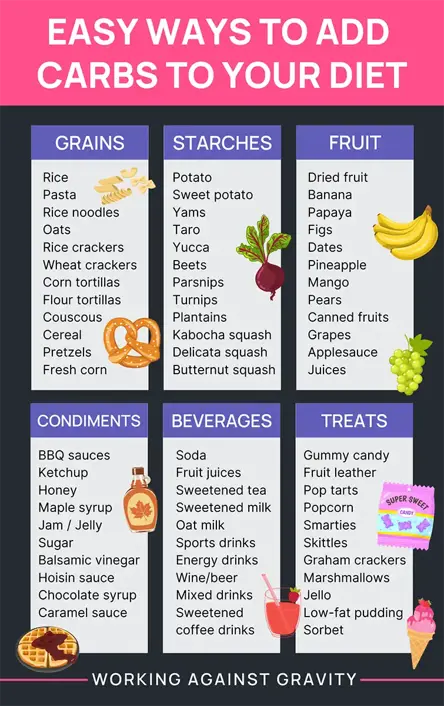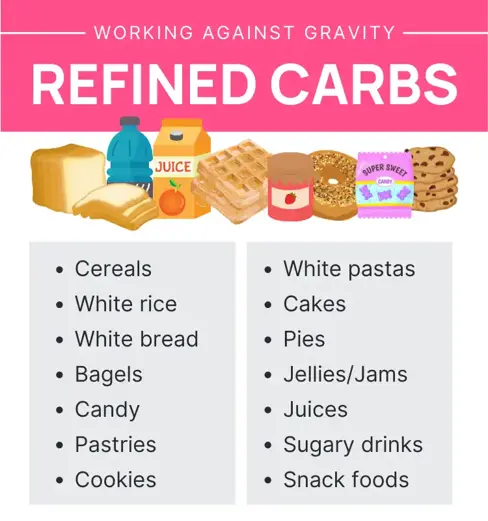
At some point in your journey, your nutrition coach may suggest adding more carbohydrates to your routine. This will probably get you wondering how to eat more carbs in a way that supports your body composition and/or performance goals.
Whether you’re looking for low-volume or high-volume carbohydrate adds, quick-to-digest options, carbs to meet your refeed day macros, high-fiber choices, or carbs from whole-food sources, we’ve got you covered.
 (Pin it for later!)
(Pin it for later!)
Before we dig into how to eat more carbs, we have to tackle what carbs are, what carbs do in your body, different kinds of carbs, and a few more questions.
Advertisement
What are Carbohydrates?
Carbohydrates, protein, and fat are the three main macronutrients. Each plays an important role in your body, and each is made up of calories. There are four calories per gram of protein, four calories per gram of carbohydrate, and nine calories per gram of fat.

Carbohydrates are your body’s most readily available source of energy and can be strategically used to improve performance, support recovery, and keep you feeling full. In some instances (especially when managed by a nutrition coach!), carbs can even help you lose weight.
Why Do You Need Carbs?
After you eat carbs from fruits, veggies, or grains, they are stored in your muscles as glycogen. Your body pulls from these energy stores for movement, recovery, and more! So, eating carbs in the right proportion for your body, activity, and goals will keep your brain and muscles feeling strong and fresh.
Advertisement
Carbs are also full of vitamins and minerals that help support your immune system. These vitamins and minerals are called “micronutrients”. Learn more about them here!
How Many Carbs Do You Need?
This is the million-dollar question, right?
The amount of carbohydrates your body needs depends on many things like:
- Your workouts: People doing more high-intensity workouts likely need more carbohydrates to fuel workouts and recovery.
- How active you are throughout the rest of your day: If you have a more physically demanding job, you may need more carbs to support that movement. Read more about non-exercise activity thermogenesis (NEAT) here!
- Your food preferences: It may make sense to allocate more calories in your diet to carbohydrates if this makes it easier to stay consistent with your daily calorie intake. But, keeping protein high is important here. Then, you can pull calories from fats if you want to eat more carbs.**
- Your genetics: Some people’s bodies digest and utilize carbs better than others.
- Your goals: If you’re cutting with the goal of dropping fat, you may need fewer carbs. If you’re bulking, you may need more. Learn the differences between bulking, cutting, and maintaining (and which makes sense for you) here!
In the next section, we’ll link to our free online macro calculator, where you can dig into this a bit more. The impact of food preferences on your macros is best handled by a 1:1 online nutrition coach who can help you stay accountable to your choices and make sure you’re eating a healthy ratio of proteins, carbs, and fats.
Advertisement
How to Set Carb Macros
Learning how many grams of carbs you need per day is part of a larger macro equation. You’ll need to:
- Determine your baseline calorie needs
- Determine your goals - do you want to cut, bulk, or maintain?
- Determine your calorie needs based on those goals
- Determine the ratio of carbs, fats, and protein necessary to reach your goals
We walk you through these steps in much more detail HERE!
Net Carbs vs. Low Carbs
“What is the difference between net carbs and low carbs?”
We get this question a lot! Here’s the quick lowdown:
What are Net Carbs?
To calculate net carbs, subtract fiber and sugar alcohols from the total number of carbs in a food.
Advertisement
Net Carbs = Total Carbs - Total Fiber - Total Sugar Alcohols
For example, if you’re eating a food with 32g carbohydrates, 3g fiber, and 1g sugar alcohol, the net carbs for that food would be 28g.
28g Net Carbs = 32g Total Carbs - 3g Fiber - 1g Sugar Alcohols
At WAG Nutrition, clients usually do not count net carbs. Our coaches provide a fiber target to make sure you’re getting enough, but we count all carbs to ensure your total daily calorie intake is accurate and accounted for. This keeps math to a minimum (read: it makes everything much simpler and easier to stick to!).
What is a “Low Carb Diet"?
A low-carb diet is most often used to aid in weight loss and is accomplished by limiting the number of grains, starchy veggies, and fruits you eat. Although there isn’t an exact number that makes a carb intake considered “low”, it is generally a range of between 20-60g/day.
Advertisement
How To Eat More Carbs In Your Diet
Now that you know what carbs are, the role carbs play in your body, the difference between net carbs and low carbs, and how many carbs you need, let’s tackle the next question: Where to get carbs?
Here are three quick and easy ways to eat more carbs in your diet:
1. Stick With Single-Source Carb Foods
Most of the carbohydrate sources listed in the following charts have a limited amount of protein or fat, making it easier to add any of these foods to your daily lineup without adding too many of the other macros.
Add these foods to your grocery shopping list and keep them handy so you always have them in a pinch.
Advertisement
A quick tip: If your nutrition is focused on minimizing carbs, use these charts as a reminder of what foods to pass on for now (low-volume) or what foods to include for high fiber content (high-volume).
Higher-Carb Foods With Very Low Volume
The following chart shows a variety of foods that are very low in volume with respect to their high-carb results (a lot of grams for a very small portion size of food). They’ll take up more carbs without making you feel overly full.
These are good go-to’s if you need more carbs and hunger is LOW.

Carbohydrate Foods With Very High Volume
The following foods limit your fat and protein intake, yet allow larger portions and volume for the number of carbohydrates you’ll consume.
Many of these foods are high in water content and fiber, which adds to their volume and makes you feel full more quickly.
Advertisement
These are good go-to’s if you need more carbs and hunger is HIGH.
2. Plan Your Day Ahead of Time
Nothing is worse than getting to the end of your day, feeling full and satisfied after dinner, then checking your MacrosFirst logs and seeing that you still have tons of carbs to eat.
Planning an entire day of eating ahead of time can help you see any situations like this coming. Adjust your portion sizes and food choices before you eat so you’re not stuck feeling like you need to eat when you’re not hungry.
At WAG Nutrition, our coaches help you get comfortable with your food-tracking app and give you plenty of prepping and planning tips to make this process quick, easy, and painless. We have plenty of Macros First tutorials that can help you as well!
Advertisement
3. Get in a Routine (and Shift Your Carb Mindset)
Carbs can get a bad rap. But that is because when you think “carbs,” you probably only think about these kinds of foods…
…right?
Are Carbs Bad for You?
Carbs are not bad for you!
Although there is a time and place for the refined carbohydrates pictured above (oh hey, birthday parties and fun family celebrations), if you focus most of your carb intake on whole fruits and veggies, you’ll give your body the vitamins and minerals it needs to thrive. After all, a lot of the micronutrients your body needs come from these healthy carbs.
And remember, carbohydrates play a huge role in energy and recovery. So, if you’re an athlete who wants to lean out and/or improve body composition, carbs are going to be a major player in your journey.
Advertisement
Still have questions about how to add carbs based on your nutritional needs and preferences? When you Join Working Against Gravity, we’ll pair you with your own personal nutrition coach. You’ll have formal weekly check-ins with your coach, plus the ability to message them 24/7 anytime you need to chat.
Together, you’ll decide the steps to take to reach your goals and master healthy habits. You’ll also join our exclusive online community, where you’ll find additional accountability and support!
Schedule a Free Intro Call
Working Against Gravity has led the macro tracking and health space for over a decade. Our team doesn’t just understand the science of nutrition—we’ve spent years mastering the art of tailoring it to fit your life. That means no cookie-cutter plans, just real strategies that have worked for over 30,000 people.
Schedule a free call with our team to learn how working with a 1-on-1 WAG coach will help you reach your goals.



